tire type MAZDA MODEL MX-5 MIATA 2006 Owners Manual
[x] Cancel search | Manufacturer: MAZDA, Model Year: 2006, Model line: MODEL MX-5 MIATA, Model: MAZDA MODEL MX-5 MIATA 2006Pages: 378, PDF Size: 4.01 MB
Page 32 of 378
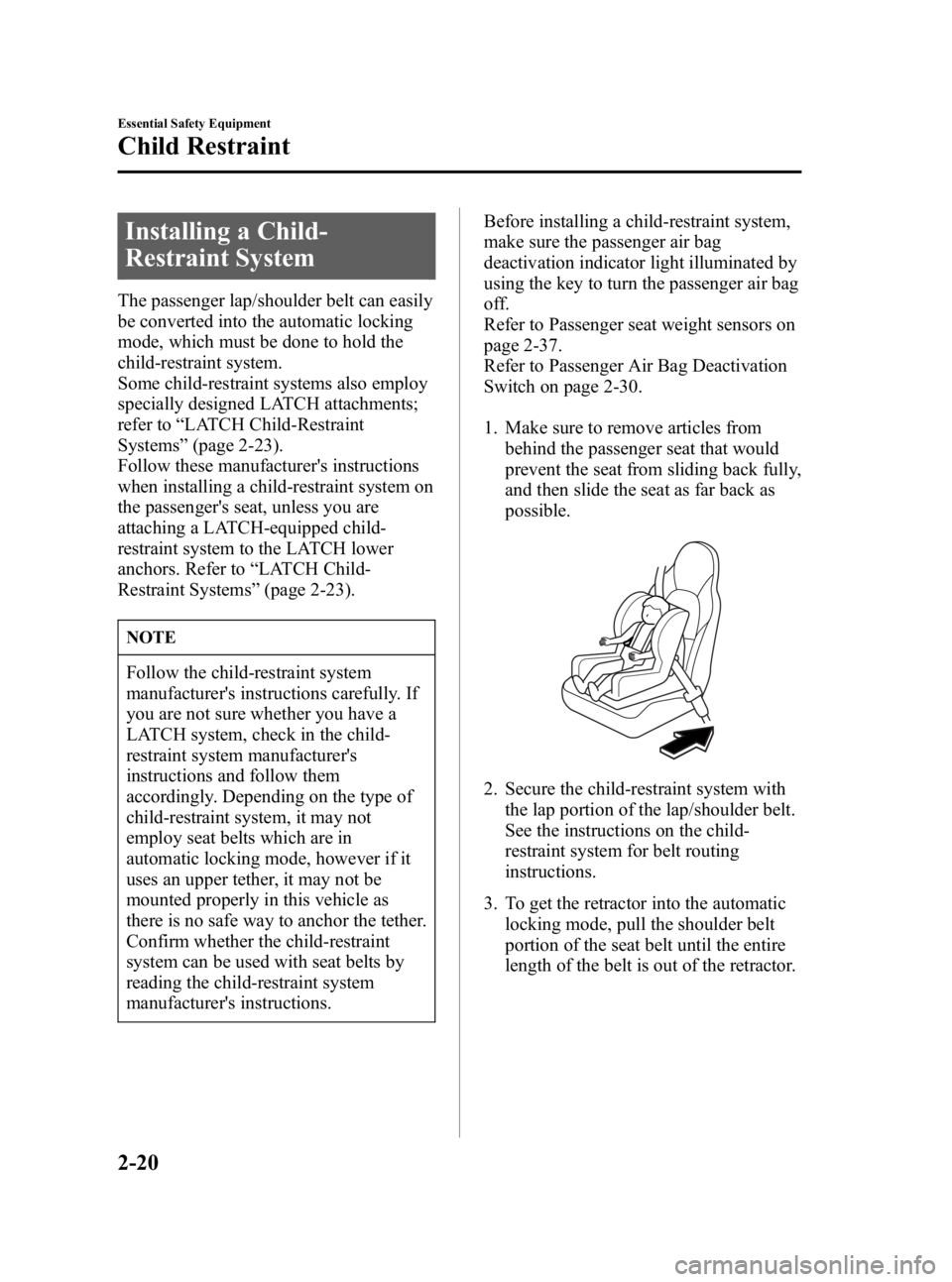
Black plate (32,1)
Installing a Child-
Restraint System
The passenger lap/shoulder belt can easily
be converted into the automatic locking
mode, which must be done to hold the
child-restraint system.
Some child-restraint systems also employ
specially designed LATCH attachments;
refer to“LATCH Child-Restraint
Systems ”(page 2-23).
Follow these manufacturer's instructions
when installing a child-restraint system on
the passenger's seat, unless you are
attaching a LATCH-equipped child-
restraint system to the LATCH lower
anchors. Refer to “LATCH Child-
Restraint Systems ”(page 2-23).
NOTE
Follow the child-restraint system
manufacturer's instructions carefully. If
you are not sure whether you have a
LATCH system, check in the child-
restraint system manufacturer's
instructions and follow them
accordingly. Depending on the type of
child-restraint system, it may not
employ seat belts which are in
automatic locking mode, however if it
uses an upper tether, it may not be
mounted properly in this vehicle as
there is no safe way to anchor the tether.
Confirm whether the child-restraint
system can be used with seat belts by
reading the child-restraint system
manufacturer's instructions. Before installing a child-restraint system,
make sure the passenger air bag
deactivation indicator light illuminated by
using the key to turn the passenger air bag
off.
Refer to Passenger seat weight sensors on
page 2-37.
Refer to Passenger Air Bag Deactivation
Switch on page 2-30.
1. Make sure to remove articles from
behind the passenger seat that would
prevent the seat from sliding back fully,
and then slide the seat as far back as
possible.
2. Secure the child-restraint system with
the lap portion of the lap/shoulder belt.
See the instructions on the child-
restraint system for belt routing
instructions.
3. To get the retractor into the automatic locking mode, pull the shoulder belt
portion of the seat belt until the entire
length of the belt is out of the retractor.
2-20
Essential Safety Equipment
Child Restraint
MX-5_8U35-EA-05F_Edition4 Page32
Thursday, October 6 2005 11:2 AM
Form No.8U35-EA-05F
Page 132 of 378
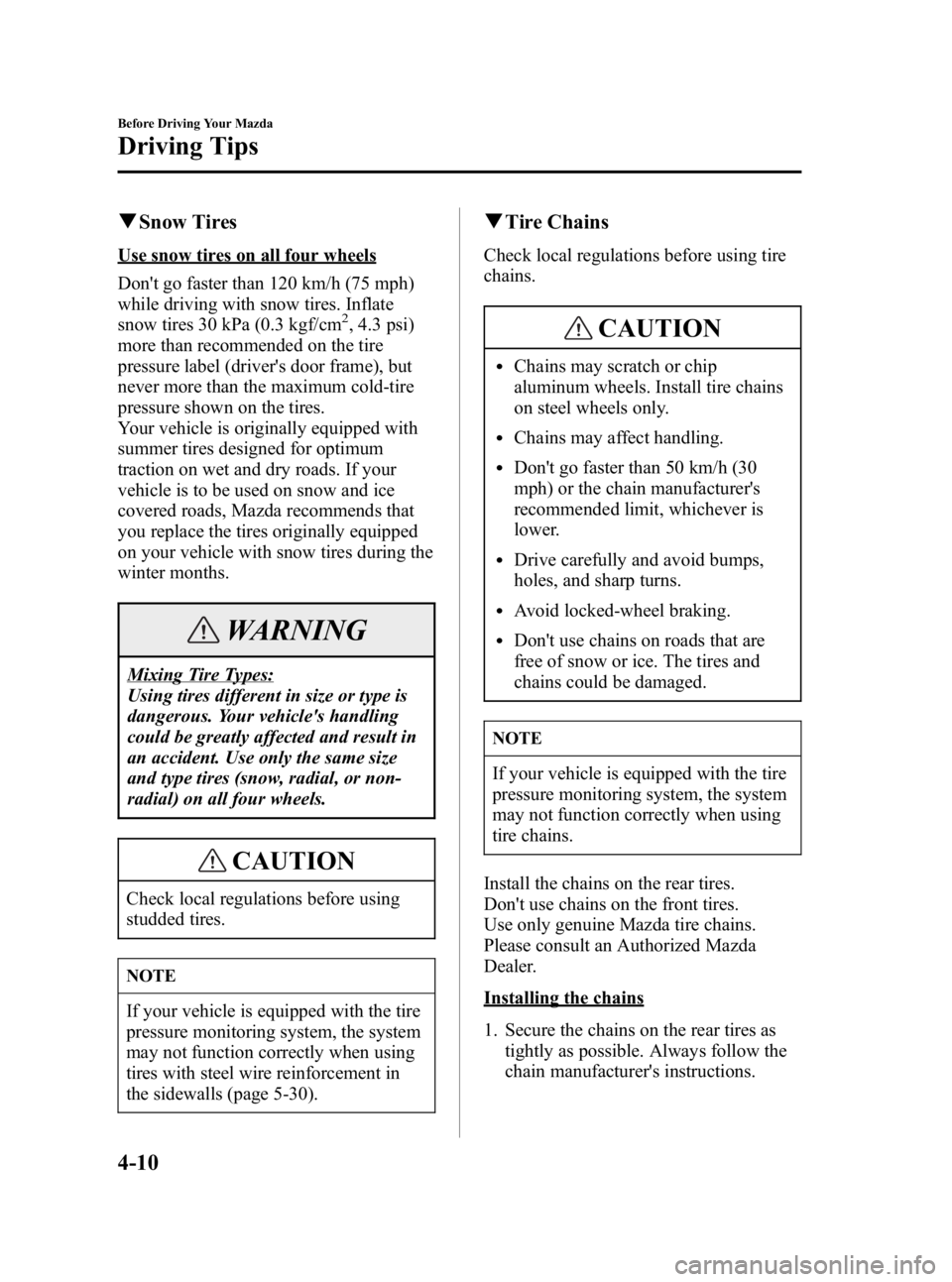
Black plate (132,1)
qSnow Tires
Use snow tires on all four wheels
Don't go faster than 120 km/h (75 mph)
while driving with snow tires. Inflate
snow tires 30 kPa (0.3 kgf/cm
2, 4.3 psi)
more than recommended on the tire
pressure label (driver's door frame), but
never more than the maximum cold-tire
pressure shown on the tires.
Your vehicle is originally equipped with
summer tires designed for optimum
traction on wet and dry roads. If your
vehicle is to be used on snow and ice
covered roads, Mazda recommends that
you replace the tires originally equipped
on your vehicle with snow tires during the
winter months.
WARNING
Mixing Tire Types:
Using tires different in size or type is
dangerous. Your vehicle's handling
could be greatly affected and result in
an accident. Use only the same size
and type tires (snow, radial, or non-
radial) on all four wheels.
CAUTION
Check local regulations before using
studded tires.
NOTE
If your vehicle is equipped with the tire
pressure monitoring system, the system
may not function correctly when using
tires with steel wire reinforcement in
the sidewalls (page 5-30).
q Tire Chains
Check local regulations before using tire
chains.
CAUTION
lChains may scratch or chip
aluminum wheels. Install tire chains
on steel wheels only.
lChains may affect handling.
lDon't go faster than 50 km/h (30
mph) or the chain manufacturer's
recommended limit, whichever is
lower.
lDrive carefully and avoid bumps,
holes, and sharp turns.
lAvoid locked-wheel braking.
lDon't use chains on roads that are
free of snow or ice. The tires and
chains could be damaged.
NOTE
If your vehicle is equipped with the tire
pressure monitoring system, the system
may not function correctly when using
tire chains.
Install the chains on the rear tires.
Don't use chains on the front tires.
Use only genuine Mazda tire chains.
Please consult an Authorized Mazda
Dealer.
Installing the chains
1. Secure the chains on the rear tires as tightly as possible. Always follow the
chain manufacturer's instructions.
4-10
Before Driving Your Mazda
Driving Tips
MX-5_8U35-EA-05F_Edition4 Page132
Thursday, October 6 2005 11:3 AM
Form No.8U35-EA-05F
Page 167 of 378

Black plate (167,1)
When changing tires yourself
If you or someone else changes tires, you
or someone else can also undertake the
steps for the TPMS to complete the ID
signal code registration.
1. After tires have been changed, turn theignition switch to the ON position, then
turn it back to the ACC or LOCK
position.
2. Wait for about 15 minutes.
3. After about 15 minutes, drive the vehicle at a speed of at least 25 km/h
(16 mph) for 10 minutes and the tire
pressure sensor ID signal code will be
registered automatically.
NOTE
If the vehicle is driven within about 15
minutes of changing tires, the tire
pressure monitoring system warning
light will flash because the sensor ID
signal code would not have been
registered. If this happens, park the
vehicle for about 15 minutes, after
which the sensor ID signal code will
register upon driving the vehicle for 10
minutes.
Replacing tires and wheels
CAUTION
lWhen replacing/repairing the tires or
wheels or both, have the work done
by an Authorized Mazda Dealer, or
the tire pressure sensors may be
damaged.
lThe wheels equipped on your Mazda
are specially designed for installation
of the tire pressure sensors. Do not
use non-genuine wheels, otherwise it
may not be possible to install the tire
pressure sensors.
Be sure to have the tire pressure sensors
installed whenever tires or wheels are
replaced.
When having a tire or wheel or both
replaced, the following types of tire
pressure sensor installation are possible.
lThe tire pressure sensor is removed
from the old wheel and installed to the
new one.
lThe same tire pressure sensor is used
with the same wheel. Only the tire is
replaced.
lA new tire pressure sensor is installed
to a new wheel.
Driving Your Mazda
Starting and Driving
5-31
MX-5_8U35-EA-05F_Edition4 Page167
Thursday, October 6 2005 11:3 AM
Form No.8U35-EA-05F
Page 241 of 378

Black plate (241,1)
Flat Tire
Either run-flat tires or conventional tires
are equipped on your Mazda depending
on the specification, therefore the
procedure for repairing a flat tire differs
depending on the type of tire. Before
driving, make sure which type of tire is
equipped on your Mazda. If you cannot
identify your tire type, consult an
Authorized Mazda Dealer.
qHow to identify your tire type
Run-flat tire
A run-flat tire has a “RFT ”mark on the
side wall.
Conventional tire
A conventional tire does not have a
“ RFT ”mark on the side wall.
q Vehicle with run-flat tires
WARNING
Vehicle Handling When Flat Tire
Warning Light Illuminates:
When the flat tire warning light
illuminates or the tire pressure
warning beep sound is heard, it is
dangerous to drive the vehicle at high
speeds, or perform sudden
maneuvering or braking. Vehicle
drivability could worsen and result in
an accident.
When the flat tire warning light
illuminates or the tire pressure
warning beep sound is heard, decrease
vehicle speed immediately and avoid
sudden maneuvering and braking.
Have the tires checked or perform the
appropriate repair as soon as possible
by an Authorized Mazda Dealer.
If a run-flat tire is punctured, the FLAT
TIRE warning light illuminates in the
instrument cluster, and a beep sound is
heard for about 30 seconds.
NOTE
Until the flat tire is changed, the beep
sound is heard for about 30 seconds
every time the ignition switch is turned
to the ON position.
In Case of an Emergency
Flat Tire
7-3
MX-5_8U35-EA-05F_Edition4 Page241
Thursday, October 6 2005 11:4 AM
Form No.8U35-EA-05F
Page 273 of 378
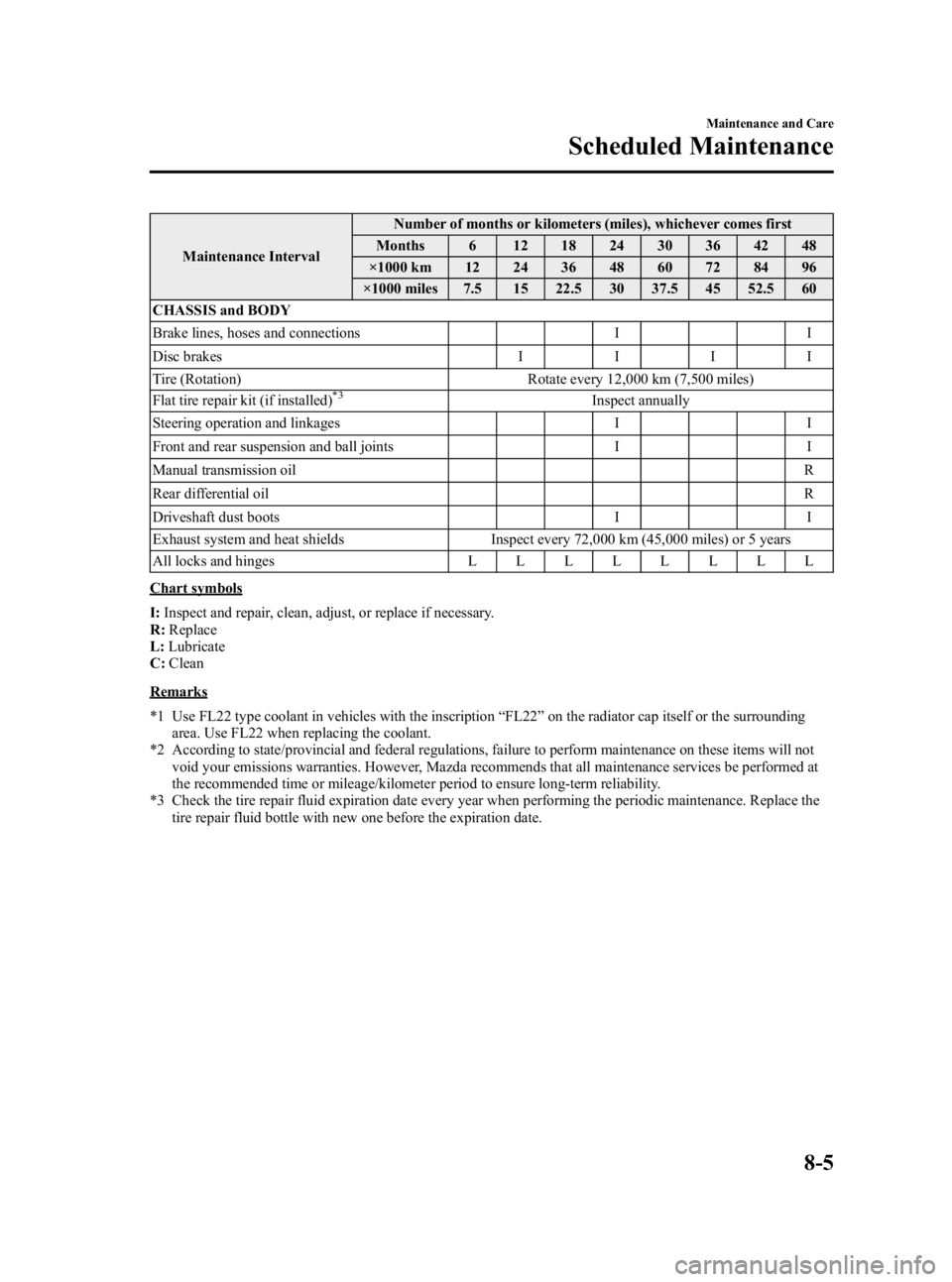
Black plate (273,1)
Maintenance IntervalNumber of months or kilometers (miles), whichever comes first
Months 6 12 18 24 30 36 42 48
×1000 km 12 24 36 48 60 72 84 96
×1000 miles 7.5 15 22.5 30 37.5 45 52.5 60
CHASSIS and BODY
Brake lines, hoses and connections I I
Disc brakes IIII
Tire (Rotation) Rotate every 12,000 km (7,500 miles)
Flat tire repair kit (if installed)
*3Inspect annually
Steering operation and linkages II
Front and rear suspension and ball joints II
Manual transmission oil R
Rear differential oil R
Driveshaft dust boots II
Exhaust system and heat shields Inspect every 72,000 km (45,000 miles) or 5 years
All locks and hinges LLLLLLLL
Chart symbols
I:Inspect and repair, clean, adjust, or replace if necessary.
R: Replace
L: Lubricate
C: Clean
Remarks
*1 Use FL22 type coolant in vehicles with the inscription “FL22 ”on the radiator cap itself or the surrounding
area. Use FL22 when replacing the coolant.
*2 According to state/provincial and federal regulations, failure to perform maintenance on these items will not
void your emissions warranties. However, Mazda recommends that all maintenance services be performed at
the recommended time or mileage/kilometer period to ensure long-term reliability.
*3 Check the tire repair fluid expiration date every year when performing the periodic maintenance. Replace the tire repair fluid bottle with new one before the expiration date.
Maintenance and Care
Scheduled Maintenance
8-5
MX-5_8U35-EA-05F_Edition4 Page273
Thursday, October 6 2005 11:5 AM
Form No.8U35-EA-05F
Page 275 of 378
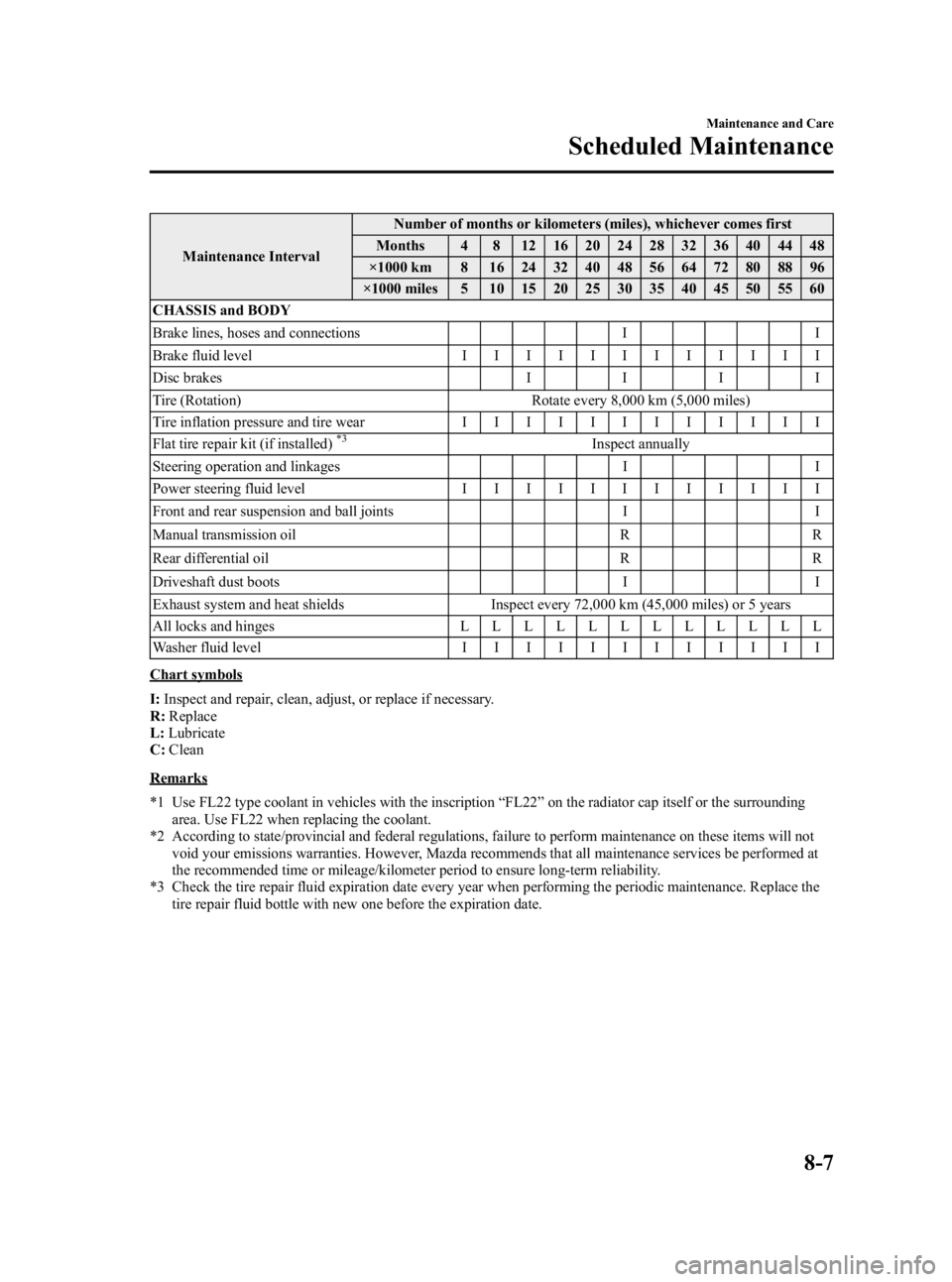
Black plate (275,1)
Maintenance IntervalNumber of months or kilometers (miles), whichever comes first
Months 4 8 12 16 20 24 28 32 36 40 44 48
×1000 km 8 16 24 32 40 48 56 64 72 80 88 96
×1000 miles 5 10 15 20 25 30 35 40 45 50 55 60
CHASSIS and BODY
Brake lines, hoses and connections I I
Brake fluid level IIIIIIIIIIII
Disc brakes IIII
Tire (Rotation) Rotate every 8,000 km (5,000 miles)
Tire inflation pressure and tire wear IIIIIIIIIIII
Flat tire repair kit (if installed)
*3Inspect annually
Steering operation and linkages II
Power steering fluid level IIIIIIIIIIII
Front and rear suspension and ball joints II
Manual transmission oil RR
Rear differential oil RR
Driveshaft dust boots II
Exhaust system and heat shields Inspect every 72,000 km (45,000 miles) or 5 years
All locks and hinges LLLLLLLLLLLL
Washer fluid level IIIIIIIIIIII
Chart symbols
I:Inspect and repair, clean, adjust, or replace if necessary.
R: Replace
L: Lubricate
C: Clean
Remarks
*1 Use FL22 type coolant in vehicles with the inscription “FL22 ”on the radiator cap itself or the surrounding
area. Use FL22 when replacing the coolant.
*2 According to state/provincial and federal regulations, failure to perform maintenance on these items will not void your emissions warranties. However, Mazda recommends that all maintenance services be performed at
the recommended time or mileage/kilometer period to ensure long-term reliability.
*3 Check the tire repair fluid expiration date every year when performing the periodic maintenance. Replace the tire repair fluid bottle with new one before the expiration date.
Maintenance and Care
Scheduled Maintenance
8-7
MX-5_8U35-EA-05F_Edition4 Page275
Thursday, October 6 2005 11:5 AM
Form No.8U35-EA-05F
Page 278 of 378
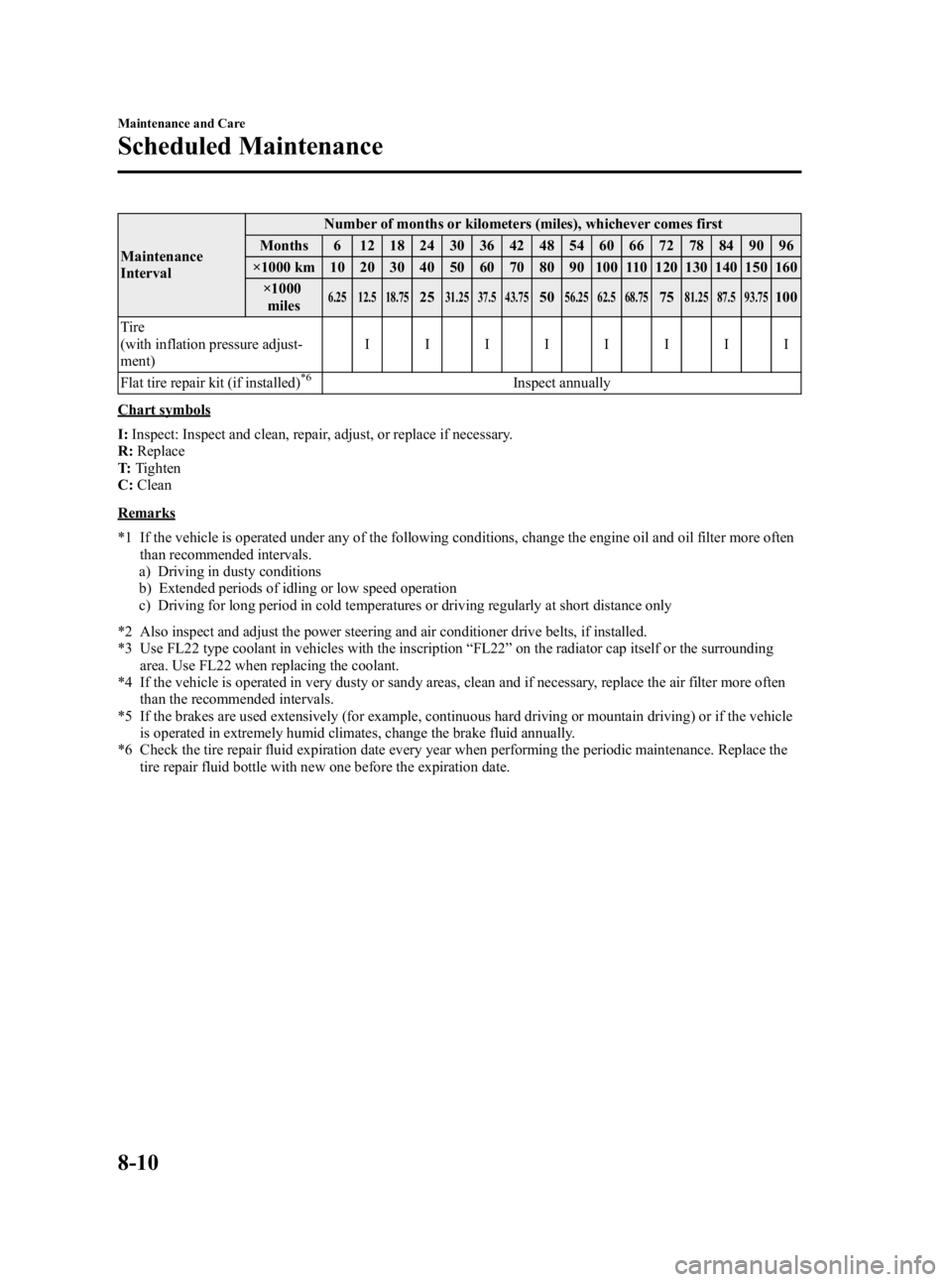
Black plate (278,1)
Maintenance
IntervalNumber of months or kilometers (miles), whichever comes first
Months 6 12 18 24 30 36 42 48 54 60 66 72 78 84 90 96
×1000 km 10 20 30 40 50 60 70 80 90 100 110 120 130 140 150 160 ×1000miles
6.25 12.5 18.752531.25 37.5 43.755056.25 62.5 68.757581.25 87.5 93.75100
Tire
(with inflation pressure adjust-
ment) IIIIIIII
Flat tire repair kit (if installed)
*6Inspect annually
Chart symbols
I: Inspect: Inspect and clean, repair, adjust, or replace if necessary.
R: Replace
T: Tighten
C: Clean
Remarks
*1 If the vehicle is operated under any of the following conditions, change the engine oil and oil filter more often
than recommended intervals.
a) Driving in dusty conditions
b) Extended periods of idling or low speed operation
c) Driving for long period in cold temperatures or driving regularly at short distance only
*2 Also inspect and adjust the power steering and air conditioner drive belts, if installed.
*3 Use FL22 type coolant in vehicles with the inscription “FL22 ”on the radiator cap itself or the surrounding
area. Use FL22 when replacing the coolant.
*4 If the vehicle is operated in very dusty or sandy areas, clean and if necessary, replace the air filter more often than the recommended intervals.
*5 If the brakes are used extensively (for example, continuous hard driving or mountain driving) or if the vehicle is operated in extremely humid climates, change the brake fluid annually.
*6 Check the tire repair fluid expiration date every year when performing the periodic maintenance. Replace the
tire repair fluid bottle with new one before the expiration date.
8-10
Maintenance and Care
Scheduled Maintenance
MX-5_8U35-EA-05F_Edition4 Page278
Thursday, October 6 2005 11:5 AM
Form No.8U35-EA-05F
Page 298 of 378

Black plate (298,1)
Tires
For reasons of proper performance, safety,
and better fuel economy, always maintain
recommended tire inflation pressures and
stay within the recommended load limits
and weight distribution.
WARNING
Using Different Tire Types:
Driving your vehicle with different
types of tires is dangerous. It could
cause poor handling and poor
braking; leading to loss of control.
Using Wrong-Sized Tires:
Using any other tire size than what is
specified for your Mazda (page 10-6)
is dangerous. It could seriously affect
ride, handling, ground clearance, tire
clearance, and speedometer
calibration. This could cause you to
have an accident. Use only tires that
are the correct size specified for your
Mazda.
qTire Inflation Pressure
WARNING
Incorrect Tire Inflation:
Overinflation or underinflation of tires
is dangerous. Adverse handling or
unexpected tire failure could result in
a serious accident. Always inflate the
tires to the correct pressure (page
10-6). The Tire Pressure Monitoring System
í
does not alleviate the need to check the
tire condition every day, including
whether the tires all look inflated properly.
Inspect all tire pressure monthly when the
tires are cold. Maintain recommended
pressures for the best ride, top handling,
and minimum tire wear.
When checking the tire pressures, use of a
digital tire pressure gauge is
recommended.
Refer to the specification charts (page
10-6).
8-30
Maintenance and Care
íSome models.
Owner Maintenance
MX-5_8U35-EA-05F_Edition4 Page298
Thursday, October 6 2005 11:6 AM
Form No.8U35-EA-05F
Page 300 of 378

Black plate (300,1)
CAUTION
Limited-Slip Differential system;
don't use the following:
lTires not of the designated size
lTires of different sizes or types at the
same time
lTires not sufficiently inflated
If these instructions aren't followed, the
rotation of the left and right wheels will
be different and will thus apply a
constant load on the limited-slip
differential.
This will cause a malfunction.
q Replacing a Tire
WARNING
Worn Tires:
Driving with worn tires is dangerous.
Reduced braking, steering, and
traction could result in an accident.
Always use tires that are in good
condition.
CAUTION
(With Tire Pressure Monitoring
System)
When replacing/repairing the tires or
wheels or both, have the work done by
an Authorized Mazda Dealer, or the tire
pressure sensors may be damaged.
NOTE
(With Tire Pressure Monitoring
System)
lWhen tires with steel wire
reinforcement in the sidewalls are
used, the system may not function
correctly even with a genuine wheel.
Refer to System Error Activation on
page 5-30.
lBe sure to install the tire pressure
sensors whenever tires or wheels are
replaced.
Refer to Tires and Wheels on page
5-30.
If a tire wears evenly, a wear indicator
will appear as a solid band across the
tread.
Replace the tire when this happens.
New tread Tread wear indicator
Worn tread
You should replace it before the band is
across the entire tread.
8-32
Maintenance and Care
Owner Maintenance
MX-5_8U35-EA-05F_Edition4 Page300
Thursday, October 6 2005 11:6 AM
Form No.8U35-EA-05F
Page 345 of 378

Black plate (345,1)
Tread Wear, Traction and Temperature Grades
Tread wear:The tread wear grade is a comparative rating based on the wear rate of the tire
when tested under controlled conditions on a specified government test course. For
example, a tire graded 150 would wear one and one-half (1 1/2) times as well on the
government course as a tire graded 100.
Traction: The traction grades, from highest to lowest are AA, A, B, and C. The grades
represent the tire's ability to stop on wet pavement as measured under controlled conditions
on specified government test surfaces of asphalt and concrete. A tire marked C may have
poor traction performance.
Temperature: The temperature grades are A (the highest), B and C, representing the tire's
resistance to the generation of heat and its ability to dissipate heat when tested under
controlled conditions on a specified indoor laboratory test wheel.
Snow Tires
In some heavy snow areas, local governments may require true snow tires, those with very
deeply cut tread. These tires should only be used in pairs or placed on all four wheels.
Make sure you purchase snow tires that are the same size and construction type as the other
tires on your vehicle.
SAFETY WARNING
The following safety warning appears on the tire's sidewall.
SERIOUS INJURY MAY RESULT FROM:
lEXPLOSION OF TIRE/RIM ASSEMBLY DUE TO IMPROPER MOUNTING-
MATCH TIRE DIAMETER TO RIM DIAMETER; NEVER EXCEED 40 psi (275 kPa)
TO SEAT BEADS-ONLY SPECIALLY TRAINED PERSONS SHOULD MOUNT
TIRES.
lTIRE FAILURE DUE TO UNDER-INFLATION/OVERLOADING/DAMAGE-
FOLLOW OWNER'S MANUAL AND PLACARD IN VEHICLE-FREQUENTLY
CHECK INFLATION PRESSURE AND INSPECT FOR DAMAGE.
Customer Information and Reporting Safety Defects
Tire Information (U.S.A.)
9-21
MX-5_8U35-EA-05F_Edition4 Page345
Thursday, October 6 2005 11:6 AM
Form No.8U35-EA-05F